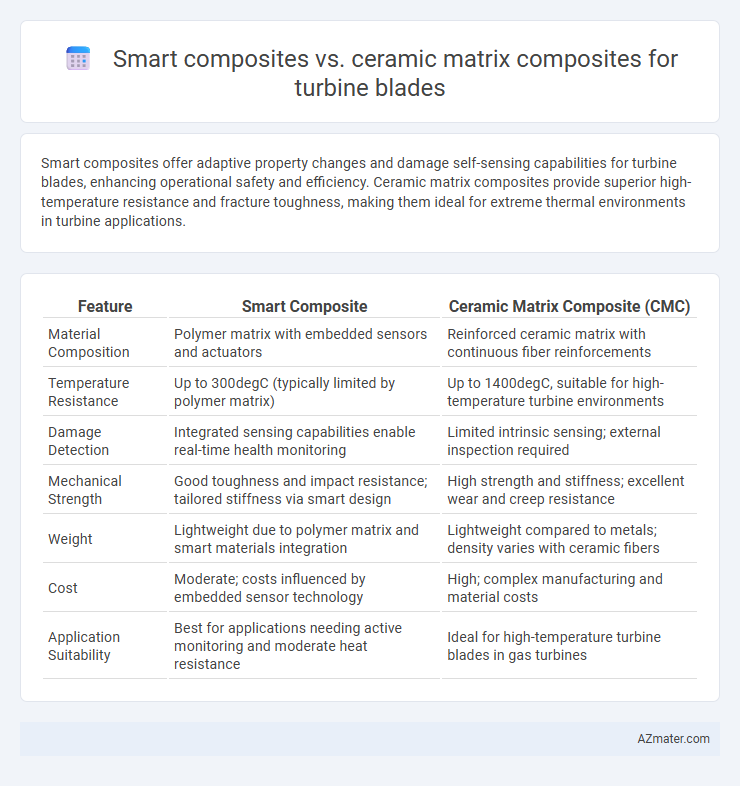Smart composites offer adaptive property changes and damage self-sensing capabilities for turbine blades, enhancing operational safety and efficiency. Ceramic matrix composites provide superior high-temperature resistance and fracture toughness, making them ideal for extreme thermal environments in turbine applications.
Table of Comparison
| Feature | Smart Composite | Ceramic Matrix Composite (CMC) |
|---|---|---|
| Material Composition | Polymer matrix with embedded sensors and actuators | Reinforced ceramic matrix with continuous fiber reinforcements |
| Temperature Resistance | Up to 300degC (typically limited by polymer matrix) | Up to 1400degC, suitable for high-temperature turbine environments |
| Damage Detection | Integrated sensing capabilities enable real-time health monitoring | Limited intrinsic sensing; external inspection required |
| Mechanical Strength | Good toughness and impact resistance; tailored stiffness via smart design | High strength and stiffness; excellent wear and creep resistance |
| Weight | Lightweight due to polymer matrix and smart materials integration | Lightweight compared to metals; density varies with ceramic fibers |
| Cost | Moderate; costs influenced by embedded sensor technology | High; complex manufacturing and material costs |
| Application Suitability | Best for applications needing active monitoring and moderate heat resistance | Ideal for high-temperature turbine blades in gas turbines |
Introduction to Advanced Turbine Blade Materials
Smart composites incorporate sensors and self-healing capabilities, enhancing turbine blade durability and real-time performance monitoring. Ceramic matrix composites (CMCs) offer superior high-temperature resistance and reduced weight, critical for extending blade lifespan in extreme environments. Both materials represent advanced solutions to improve efficiency and reliability in modern turbine technology.
Overview of Smart Composites
Smart composites integrate sensors and actuators within the matrix to monitor real-time stress, temperature, and deformation in turbine blades, enhancing their adaptive performance. These materials offer superior damage detection and self-healing capabilities compared to traditional ceramic matrix composites (CMCs), which mainly provide high-temperature resistance and durability. Incorporating smart composite technology into turbine blades improves operational efficiency and extends service life by enabling proactive maintenance and dynamic response to changing flight conditions.
Fundamentals of Ceramic Matrix Composites (CMCs)
Ceramic Matrix Composites (CMCs) consist of ceramic fibers embedded in a ceramic matrix, offering superior high-temperature resistance and thermal stability essential for turbine blade applications. Their fundamental advantage over smart composites lies in their ability to maintain mechanical integrity at temperatures exceeding 1,200degC, enabling enhanced engine efficiency and durability. The inherent oxidation resistance and low density of CMCs reduce cooling requirements and overall turbine weight, making them critical in advanced aerospace propulsion systems.
Mechanical Properties: Strength, Toughness, and Durability
Smart composites for turbine blades often exhibit enhanced toughness and adaptive strength through embedded sensors and self-healing abilities, optimizing in-service durability under variable stress conditions. Ceramic matrix composites (CMCs) provide superior high-temperature strength and thermal shock resistance, essential for maintaining structural integrity in extreme turbine environments. While CMCs excel in maintaining mechanical properties at elevated temperatures, smart composites offer improved damage tolerance and real-time condition monitoring, contributing to longer service life and reduced maintenance.
Thermal Performance and Heat Resistance
Smart composites for turbine blades offer enhanced thermal performance through adaptive microstructures that dissipate heat efficiently, maintaining structural integrity at temperatures up to 1200degC. Ceramic matrix composites (CMCs) provide superior heat resistance withstanding extreme environments exceeding 1300degC, due to their inherent oxidation and thermal shock resistance. Compared to smart composites, CMCs exhibit lower thermal conductivity, which improves insulation but may require advanced cooling strategies to optimize turbine blade lifespan.
Corrosion and Oxidation Resistance
Smart composites for turbine blades offer enhanced corrosion resistance through self-healing coatings that actively repair micro-cracks, reducing oxidation-induced degradation at high temperatures. Ceramic matrix composites (CMCs) provide superior oxidation resistance due to their inherent thermal stability and formation of protective oxide scales, maintaining mechanical integrity under extreme turbine operating conditions. Compared to conventional materials, CMCs ensure longer service life and reduced maintenance costs by minimizing oxidation and corrosion-related failures in turbine environments.
Manufacturing Techniques and Scalability
Smart composites for turbine blades often employ advanced fiber placement and automated layup techniques, enabling precise fiber orientation and embedding sensors for real-time monitoring, which enhances manufacturing scalability. Ceramic matrix composites (CMCs) require complex processes such as chemical vapor infiltration (CVI) or polymer infiltration and pyrolysis (PIP), making their production more time-consuming and less scalable compared to smart composites. The scalability of smart composites is further supported by additive manufacturing advancements, whereas CMCs face challenges due to high-temperature processing and material brittleness, limiting large-scale manufacturing.
Cost Comparison and Lifecycle Analysis
Smart composites for turbine blades generally incur lower upfront costs compared to ceramic matrix composites (CMCs) due to simpler manufacturing processes and less expensive raw materials. Lifecycle analysis reveals CMCs offer superior high-temperature resistance and longer service life, reducing maintenance and replacement frequency despite higher initial investment. The cost-benefit ratio favors CMCs in high-performance, long-term applications, while smart composites suit budget-sensitive projects with shorter operational demands.
Application Suitability in Modern Turbine Engines
Smart composites, integrating sensors and adaptive materials, enhance turbine blade performance by enabling real-time monitoring and damage detection in modern turbine engines. Ceramic matrix composites (CMCs) offer superior high-temperature resistance and thermal stability, making them highly suitable for turbine blades exposed to extreme combustion environments. The selection between smart composites and CMCs hinges on the need for active health management versus exceptional thermal endurance in next-generation turbine engine applications.
Future Trends: Innovations and Potential Drawbacks
Smart composites for turbine blades integrate embedded sensors and adaptive materials to enable real-time health monitoring and damage response, enhancing operational efficiency and lifespan. Ceramic matrix composites (CMCs) offer high-temperature resistance and reduced weight, critical for next-generation turbine performance, but face challenges in manufacturing complexity and brittleness under impact. Future trends emphasize hybridizing smart composites with CMCs to combine durability with intelligent functionality, while addressing cost and reliability concerns through advanced fabrication and material design innovations.

Infographic: Smart composite vs Ceramic matrix composite for Turbine blade
 azmater.com
azmater.com